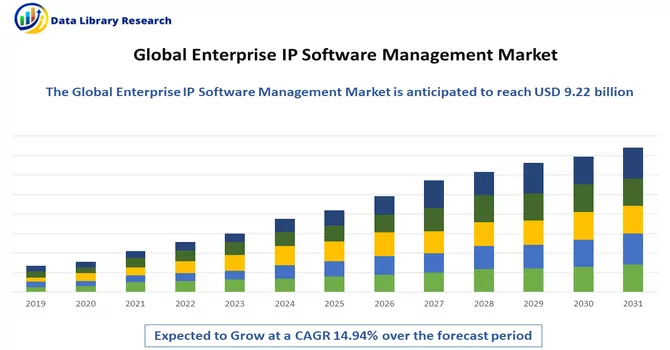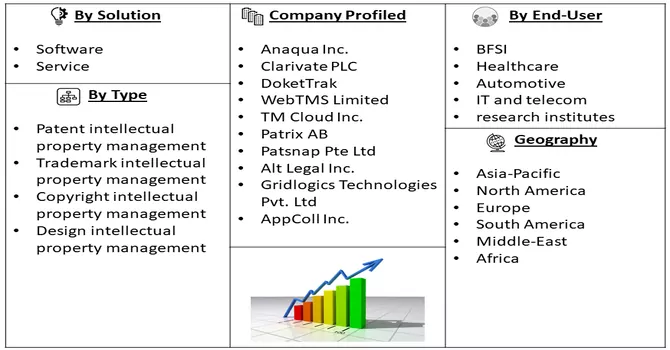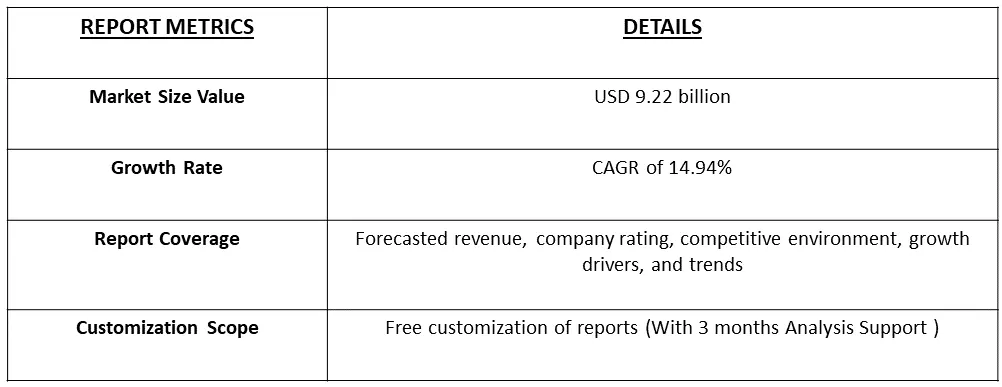The Intellectual Property (IP) Management Software Market size was estimated at USD 9.22 billion in the current year, 2023 registering a CAGR of 14.94% during the forecast period, 2024-2030.

Get Complete Analysis Of The Report - Download Free Sample PDF
Enterprise IP Management Software is a category of software solutions crafted to assist organizations in the efficient management and safeguarding of their intellectual property assets. Intellectual property encompasses patents, trademarks, copyrights, trade secrets, and other intangible assets that play a pivotal role in establishing a company's competitive edge. Enterprise IP Management Software helps in the registration, monitoring, and protection of trademarks. This involves tracking the status of trademark applications, managing renewals, and ensuring compliance with trademark laws.
The increasing number of patent, trademark, and copyright filings globally contributes to the demand for software solutions that can efficiently manage the complexities associated with intellectual property portfolios. The software helps in streamlining the filing, tracking, and maintenance of these assets. For instance, in November 2023, the World Intellectual Property Organization (WIPO) revealed that innovators worldwide submitted 3.46 million patent applications in 2022, marking the third consecutive year of growth. The source also reported that in 2022, China, the United States, Japan, the Republic of Korea, and Germany emerged as the leading countries in terms of patent filings. China, responsible for nearly half of all global patent applications, experienced a dip in its growth rate for the second consecutive year, decreasing from 6.8% in 2021 to 3.1% in 2022. In contrast, India witnessed a remarkable surge, with patent applications by residents growing by 31.6% in 2022, extending an 11-year streak of growth unmatched by any other country among the top 10 filers. Thus, such instances are significantly increasing the demand for IP management software, thereby propelling the growth of the studied market.
Market Segmentation: Global Intellectual Property Management Software Market report is segmented by solution (software, and service), type (patent intellectual property management, trademark intellectual property management, copyright intellectual property management, and design intellectual property management), end user (BFSI, healthcare, automotive, IT and telecom, and research institutes), and Geography (North America, Europe, Asia-Pacific, South America, and Middle-East and Africa). The market sizes and forecasts are provided in terms of value (USD billion) for all the above segments.

For Detailed Market Segmentation - Download Free Sample PDF
There is a trend towards developing mobile-friendly IP Management Software, allowing users to manage and access intellectual property assets on mobile devices. This trend aligns with the increasing reliance on mobile technology for business operations. For instance, in 2023, Clarivate Plc launched the next-generation artificial intelligence (AI)-driven solution designed to enable intellectual property (IP) professionals worldwide to confidently and efficiently optimize their IP portfolios and strategy. Thus, such product developments are expected to drive the growth of the studied market over the forecast period. The trend towards valuing intellectual property is leading to the integration of IP valuation services within the software. This enables organizations to assess the monetary value of their intellectual property portfolios.
Market Drivers:
Growing Acknowledgment of Intellectual Property
The growing acknowledgement of intellectual property as a critical business asset has driven organizations to invest in dedicated software solutions for its effective management. IP is seen as a key driver of competitiveness and innovation. For instance, WIPO reported that IP provides legal protection for innovative ideas, inventions, and creations. Patents, trademarks, and copyrights safeguard the rights of inventors, creators, and innovators, encouraging them to invest time and resources in developing new and unique products or services. Thus, owing to such advantages, there is growing IP filing, which is demand for IP software, which is driving the growth of the studied market.
Rise in Innovations and R&D Activities
Businesses are investing heavily in innovation and research & development (R&D) to stay competitive. IP management software supports organizations in capturing, evaluating, and protecting innovations, inventions, and technologies generated through R&D efforts. For instance, in April 2022, Anaqua, a technology provider specializing in innovation and IP management, unveiled an automated information disclosure solution as an integral component of its AQX IP management suite for corporations and law firms. This innovative system is designed to assist IP professionals in both time and cost savings by simplifying and automating the Information Disclosure Statement (IDS) process.
Moreover, the strategic developments are further driving the market growth. For instance, in March 2022, Questel successfully completed the acquisition of Markify, a prominent provider of trademark-watching and searching services. This strategic move granted Questel entry into the expansive trademark database held by Markify, positioning Questel to provide comprehensive global end-to-end Intellectual Property services. Thus, such factors are expected to drive the growth of the studied market over the forecast period.
Market Restraints:
Enterprise IP Software Management Market High Cost
Implementing IP Management Software often involves significant upfront costs, including licensing fees, customization, and integration expenses. This can be a deterrent for smaller organizations or those with limited budgets. For instance, the rough price for IP software varies in between USD 1000 and USD 1200. Such high costs may limit the access to these software, thereby slowing down the growth of the studied market.
The IP software management market witnessed notable changes driven by the remote working environment and the need for efficient intellectual property management. Organizations faced operational challenges in managing and protecting intellectual property as teams transitioned to remote work setups. The increased reliance on digital platforms prompted organizations to accelerate their digital transformation initiatives, including the adoption of advanced IP software management solutions. IP software that facilitated remote collaboration and secure information sharing gained prominence, addressing the need for seamless virtual workflows. Thus, initially market faced significant challenges, but post-pandemic the market is expected to witness significant growth over the forecast period.
Segmental Analysis:
Software Segment is Expected to Witness Significant Growth Over the Forecast Period
Effective software management involves the systematic control and optimization of software assets throughout their lifecycle. This encompasses acquisition, deployment, utilization tracking, and eventual retirement or replacement. Key aspects of software management include license compliance, cost optimization, and cybersecurity. Intellectual Property Management Software addresses the unique challenges associated with safeguarding and leveraging intellectual property assets. These solutions are designed to streamline processes related to patents, trademarks, copyrights, and trade secrets. Also, combining software and IP management becomes essential for organizations seeking comprehensive control over their technological and intellectual assets. Integrated solutions offer a unified platform, allowing businesses to holistically manage both software licenses and intellectual property portfolios. Thus, owing to such factors, the segment is expected to witness significant growth over the forecast period.
Patent Intellectual Property Management Segment is Expected to Witness Significant Growth Over the Forecast Period
Patent Intellectual Property Management is a strategic approach that involves the systematic administration of patents throughout their lifecycle, from filing to expiration. This involves the strategic creation and development of a patent portfolio aligned with the organization's business goals. It requires a comprehensive understanding of the company's technological landscape, market trends, and potential areas for innovation. Efficient management encompasses the process of filing patent applications and navigating the prosecution phase. This involves interacting with patent offices, responding to examination reports, and ensuring that granted patents align with the initial filing objectives. Patent managers must be vigilant in monitoring the landscape for potential infringements and take appropriate actions to enforce patent rights. This may involve legal proceedings, negotiations, or defensive strategies to protect against third-party claims. Thus, owing to such factors the patent filing consists of a lot of data which hereby requires a lot of data which in turn requires IP management software, thereby segment is expected to witness significant growth over the forecast period.
The Healthcare Segment is Expected to Witness Significant Growth Over the Forecast Period
The healthcare industry is at the forefront of innovation, with research, development, and technological advancements driving medical breakthroughs. Managing intellectual property (IP) within the healthcare sector is crucial for protecting innovations, ensuring compliance with regulatory standards, and ultimately delivering enhanced patient care. IP software management tailored for healthcare organizations facilitates the strategic administration of patents, trademarks, copyrights, and trade secrets, fostering a conducive environment for innovation and growth. Healthcare organizations continually generate innovations, ranging from new medical devices and treatments to software applications. IP software management ensures that these innovations are properly protected through patents, trademarks, or copyrights, preventing unauthorized use and promoting a culture of innovation. Thus, owing to such factors the segment is expected to witness significant growth over the forecast period.
Asia Pacific Region is Expected to Witness Significant Growth Over the Forecast Period
The Asia-Pacific (APAC) region stands as a dynamic hub of innovation, with diverse industries contributing to groundbreaking developments in technology, healthcare, manufacturing, and more. As intellectual property (IP) becomes a cornerstone of economic growth, efficient IP software management is paramount for organizations across APAC to protect, leverage, and strategically navigate the complexities of regional and global markets. The APAC region is characterized by a vibrant innovation ecosystem, with countries like China, Japan, South Korea, and India leading in technological advancements. Effective IP software management becomes instrumental in safeguarding inventions, patents, and trade secrets arising from this innovation landscape.

Get Complete Analysis Of The Report - Download Free Sample PDF
The market for intellectual property management software is characterized by fragmentation, with numerous vendors operating within the industry. Global major players are actively expanding their market influence through the introduction of inventive solutions and the formation of strategic partnerships. This dynamic landscape reflects a competitive environment where key players strive to enhance their market position. These companies leverage innovation and collaboration to stay at the forefront of the intellectual property management software market, contributing to its overall evolution and growth.
The market for intellectual property management software is characterized by fragmentation, with numerous vendors operating within this space. Major global market players are actively expanding their footprint by introducing cutting-edge solutions and engaging in strategic partnerships. This reflects a competitive environment where leading vendors seek to enhance their market share and influence through innovation and collaborative ventures. As these players introduce new and advanced solutions, and forge strategic alliances, the intellectual property management software market continues to evolve, providing businesses with a diverse range of options and fostering an environment of dynamic competition and innovation. Some of the key market players working in this domain are:
Recent Developments:
1) In February 2023, Resurgens Technology Partners, a private equity firm specializing in software, revealed that its portfolio entity, Wellspring, a provider of innovation and intellectual property management software, successfully finalized the acquisition of IP Pragmatics. IP Pragmatics is a consulting and services firm specializing in technology transfer and intellectual property management. The merged company now delivers extensive technology transfer and IP management software solutions, catering to a global clientele of more than 900 companies, research institutions, and government agencies.
2) In January 2020, Questel officially announced the completion of its acquisition of NRI Cyber Patent in Japan. NRI Cyber Patent specializes in offering intellectual asset management and IP business intelligence services and solutions.
Q1. What is the current Enterprise IP Software Management Market size?
The Enterprise IP Software Management Software Market size was estimated at USD 9.22 billion in the current year.
Q2. At what CAGR is the Enterprise IP Software Management market projected to grow within the forecast period?
Enterprise IP Software Management Market is registering a CAGR of 14.94% during the forecast period.
Q3. What are the factors driving the Enterprise IP Software Management Market?
Key factors that are driving the growth include the Growing Acknowledgment of Intellectual Property and Rise in Innovations and R&D Activities.
Q4. Which region has the largest share of the Enterprise IP Software Management Market? What are the largest region's market size and growth rate?
Asia-Pacific has the largest share of the market. For detailed insights on the largest region's market size and growth rate request a sample here.
Data Library Research are conducted by industry experts who offer insight on industry structure, market segmentations technology assessment and competitive landscape (CL), and penetration, as well as on emerging trends. Their analysis is based on primary interviews (~ 80%) and secondary research (~ 20%) as well as years of professional expertise in their respective industries. Adding to this, by analysing historical trends and current market positions, our analysts predict where the market will be headed for the next five years. Furthermore, the varying trends of segment & categories geographically presented are also studied and the estimated based on the primary & secondary research.
In this particular report from the supply side Data Library Research has conducted primary surveys (interviews) with the key level executives (VP, CEO’s, Marketing Director, Business Development Manager and SOFT) of the companies that active & prominent as well as the midsized organization
FIGURE 1: DLR RESEARH PROCESS

Extensive primary research was conducted to gain a deeper insight of the market and industry performance. The analysis is based on both primary and secondary research as well as years of professional expertise in the respective industries.
In addition to analysing current and historical trends, our analysts predict where the market is headed over the next five years.
It varies by segment for these categories geographically presented in the list of market tables. Speaking about this particular report we have conducted primary surveys (interviews) with the key level executives (VP, CEO’s, Marketing Director, Business Development Manager and many more) of the major players active in the market.
Secondary ResearchSecondary research was mainly used to collect and identify information useful for the extensive, technical, market-oriented, and Friend’s study of the Global Extra Neutral Alcohol. It was also used to obtain key information about major players, market classification and segmentation according to the industry trends, geographical markets, and developments related to the market and technology perspectives. For this study, analysts have gathered information from various credible sources, such as annual reports, sec filings, journals, white papers, SOFT presentations, and company web sites.
Market Size EstimationBoth, top-down and bottom-up approaches were used to estimate and validate the size of the Global market and to estimate the size of various other dependent submarkets in the overall Extra Neutral Alcohol. The key players in the market were identified through secondary research and their market contributions in the respective geographies were determined through primary and secondary research.
Forecast Model
